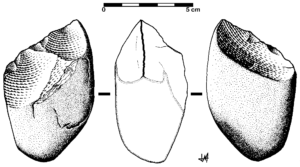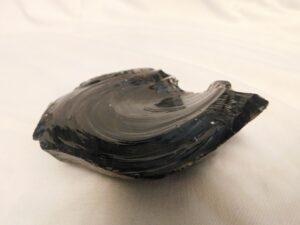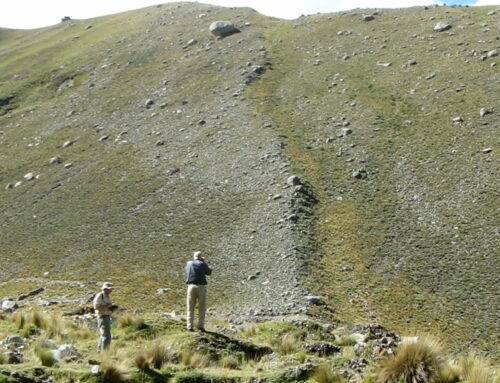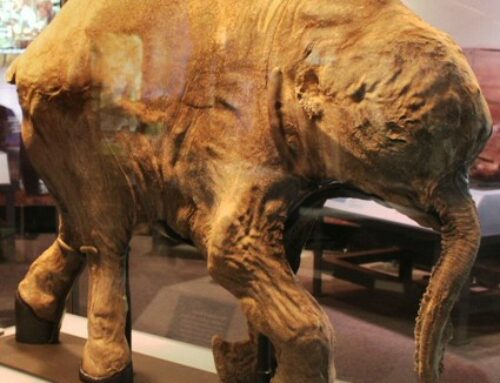Stone tools work best when made from specific kinds of rock. Careful selection of rock types began early when our human ancestors (hominins) first began using stone tools. These distant past beginnings were recently brought to my attention in an excellent article titled “The First Geologists?”, written by Jon Spencer, University of Arizona, in a Geological Society of America publication. The early use of obsidian in the Andes Mountains is also intriguing, and I’ll share stories of both in this post.
Hominin Tool Use in the East African Rift System
The trail of tool use by hominins, found in eastern Africa, extends back to around 3.4 million years ago, with scrapes and cut marks on animal bones interpreted as signs of stone-tool butchery. Around 3.3 million years, there is evidence of crude stone tools that likely were used for chopping, scraping, and/or crushing animal or plant matter. Impressively old!
From about 2.6 to 1.6 Ma, simple stone tools associated with the Oldowan culture emerge, initially discovered by Louis Leakey at Olduvai Gorge in the 1930s. These appear to have been made by throwing a stone at another stone surface, called anvil percussion, or hitting a stone held in the hand with another stone, known as core reduction. The simple tools allowed a smooth side of a rounded rock to be held, while chopping, sawing, or scraping with the deliberately chipped and shaped side. The sharp rock chips produced during the process also may have been a desired product. At the 2.34 Ma Lokalalei site west of Lake Turkana in Kenya, researchers studying tool fabrication have found some that were made with consistency in chipping the edges and faces of cores, displaying significant skill.

Drawing of a typical Oldowan chopping tool (Wikipedia)
Rivers and streams in many areas contain water-rounded pebbles and cobbles in a gravel collection of different types of local rock. As far back as about 2.5 to 2.6 Ma in east Africa, there is evidence that hominins showed preferences for certain types of volcanic rocks – those with a glassy or fine-grained composition with few suspended large crystals, such as rhyolite or dacite, and avoided others such as basalt. At Olduvai Gorge, artifact assemblages (ca. 1.7 – 1.4 Ma) include a large fraction of quartzite tools. Angular fragments that were well-suited for flake removal could be found in nearby bedrock outcrops. The selectivity displayed by these Pliocene toolmakers reflects a level of sophistication that many have not appreciated.
East Africa Rift & volcanic rocks_Spencer 2024_Fig2
Relief map of East African Rift System, showing the distribution of volcanic rocks associated with the rift system and areas where significant numbers of hominin-related stone tools and/or bones have been recovered (green squares). Rectangular symbols are on the downthrown side of normal faults. (Spencer, 2024, Figure 2)
A map of the young volcanic rocks in the East African Rift System is available in the link above (it is a large map). The information shows where the continent is slowly breaking apart and the correlation with the earliest hominin sites where archaeologists have found stone tools and/or bones with cut marks. These sites – and there are more than 20 – are almost entirely associated with the young volcanic rocks on the eastern branch of the rift. Although there could be reasons that additional stone tool sites have not been found on the western branch of the rift – from more rainfall, vegetation, and lakes to difficult political and social environments for archaeological fieldwork – the fact remains that hominins shaped most early stone tools from the young volcanic and shallow intrusive rocks associated with the eastern rift. They had identified, and were using, the most appropriate rocks for their tools. Fascinating!
Early Use of Obsidian in the Andes Mountains
Traveling to another continent, and fast forwarding more than a million years, the earliest Americans also selected the best rock types for their stone tools. About 12,000 years ago, high in the Andes Mountains of southern Peru, hunter-gatherers used alcoves in cliffs of volcanic andesite as rock shelters. Archaeologists have found that these shelters are some of the most accurately dated and highest altitude Pleistocene settlement sites on Earth – and they are at astonishingly remote elevations of around 14,500 ft (4,420 km). Ceilings covered with soot from fires, walls with rock art, and floor sediments with charred plant and animal materials reveal a long history of human occupation. Multiple radiocarbon age dates from the remains show people were using these shelters from as far back as 12,300 to 11,100 years ago. Possibly, they were being used much earlier.
Obsidian was the motivation for people to occupy the rock shelters in such a bitterly cold and treeless environment. They collected and worked pieces of this shiny glass-like substance eroding from volcanic rocks on the mountain slopes. Among the artifacts the ancient Andeans left behind, the most impressive are hundreds of projectile points, scrapers, and other tools made from obsidian and fine-grained andesite. Numerous bones found along with these objects show the early inhabitants were hunting deer and wild camelids, the ancestors of domesticated llamas and alpacas.

Conchoidal fracture on obsidian (Wikimedia)
Why was obsidian so important? The properties of this material make it well-suited for tools. Obsidian develops when lava high in silica cools extremely rapidly and forms volcanic glass. Individual atoms “freeze” in place instead of combining with other minerals and forming crystals. With no crystals present, the naturally formed glass is hard, brittle, and can produce shell-shaped, or conchoidal, fractures when struck. These properties make this material optimal for precision chipping and mean also that obsidian produces the sharpest edge of all stone artifacts.
The trail of stone tools continues into the present. Today, some surgeons use thin blades of obsidian in scalpels for precise surgery such as in eyes, as these blades have a cutting edge many times sharper than high-quality steel surgical scalpels. Humans and their ancient ancestors have taken advantage of rocks in their environment over a very long stone tool making history.
If you liked this post, please share it and/or leave a comment or question below and I will reply – thanks! And if you’d like to receive a message when I publish a new post, scroll down to the bottom of this page, and leave your email address on my website. Join now to learn more about geology, geography, culture, and history.
SOURCES
Meinekat, Sarah Ann, Christopher E. Miller, and Kurt Rademaker. “A site formation model for Cuncaicha rock shelter: Depositional and postdepositional processes at the high‐altitude keysite in the Peruvian Andes.” Geoarchaeology 37, no. 2 (2022): 304-331.
Rademaker, Kurt, Gregory Hodgins, Katherine Moore, Sonia Zarrillo, Christopher Miller, Gordon RM Bromley, Peter Leach, David A. Reid, Willy Yépez Álvarez, and Daniel H. Sandweiss. “Paleoindian settlement of the high-altitude Peruvian Andes.” Science 346, no. 6208 (2014): 466-469.
Spencer, Jon. “The first geologists?” GSA Today, v. 34 (2024): 4-10.
Stout, Dietrich, Jay Quade, Sileshi Semaw, Michael J. Rogers, and Naomi E. Levin. “Raw material selectivity of the earliest stone toolmakers at Gona, Afar, Ethiopia.” Journal of Human Evolution 48, no. 4 (2005): 365-380.
Feature photo of Oldowan chopping tool from Olduvai Gorge, approximately 1.8 million years old (British Museum, Wikipedia) 2012. https://en.wikipedia.org/wiki/Olduvai_Gorge#/media/File:Olduvai_Chopper.JPG
Photo of a typical Oldowan chopping tool, Duero Valley, Spain, 1987. https://en.wikipedia.org/wiki/Stone_tool#/media/File:Chopping_tool.gif
Relief map of East African Rift System from Spencer, 2024, Figure 2.
Photo of conchoidal fracture on obsidian, by Krassotkin, 2018. https://commons.wikimedia.org/wiki/File:13_years_of_Russian_Wikinews_in_Moscow_21.jpg






Fascinating information! Thank you. ❤️
Thanks, Diana! Glad you liked this post – I agree that it is fascinating!
Thank you for posting this Roseanne as I had just finished reading Spencer, 2024 in GSA Today. I also have a deep interest in these kinds of things. I am in possession of three hammerstones that may have been crafted by Homo rectus some half a million years ago. I have a South African colleague, who is a professional anthropologist and he would go to farmers in South Africa and ask if he could route around in the piles of stone that they had accumulated in clearing their fields. Apparently, these piles of stones were good collecting sites for out of context, early human tools. It’s wonderful to hold them in your hand and touch that distant past!
Great to hear – and fascinating – thanks, Wayne! It would definitely be amazing to hold such ancient tools in one’s hand, and reflect on our distant ancestors!
Could a scalpel made of stone really still be useful? Here is a recent reference I found: “A household razor blade is about 300-600 angstroms, while an obsidian blade is about 30 angstroms.
Under a microscope, an obsidian scalpel divides individual cells in half, while steel scalpel incisions look like they were made by a chainsaw. Even handling an obsidian scalpel takes great care because one can unknowingly cut themselves without pain because the laceration is so fine.” Amazing.
Yes! Thanks, Steve — a great reference! Obsidian is useful in eye surgery because only a small amount of pressure is needed to make a cut — also the reason it is easy to cut yourself, and not even feel it, because the blade has such a fine edge. Definitely amazing!
Excellent information! I wonder if evidence exists of even earlier tool use, as chimps and other primates use tools too. Hence common ancestors may have used them as well. But maybe there is no record if the tools were made of plants (twigs)… Etc. Fascinating…
Agreed – yes! Thanks, Kathelijne!